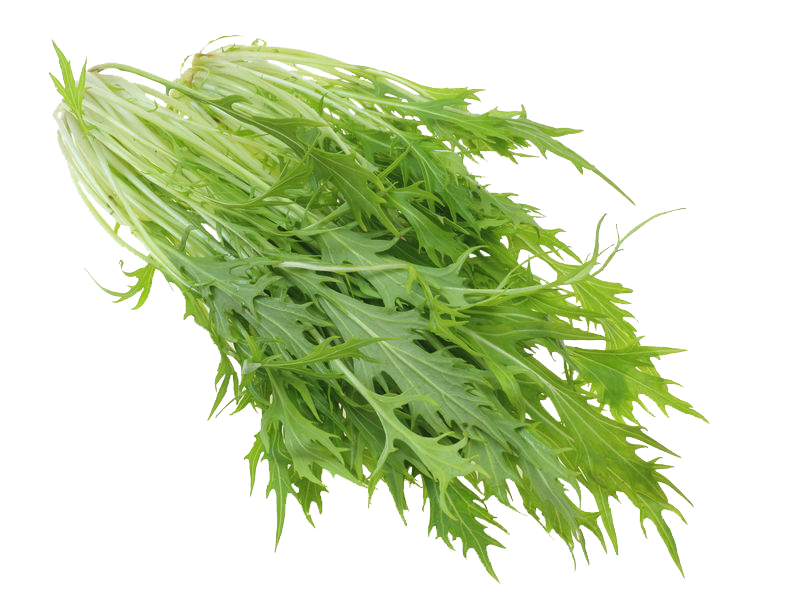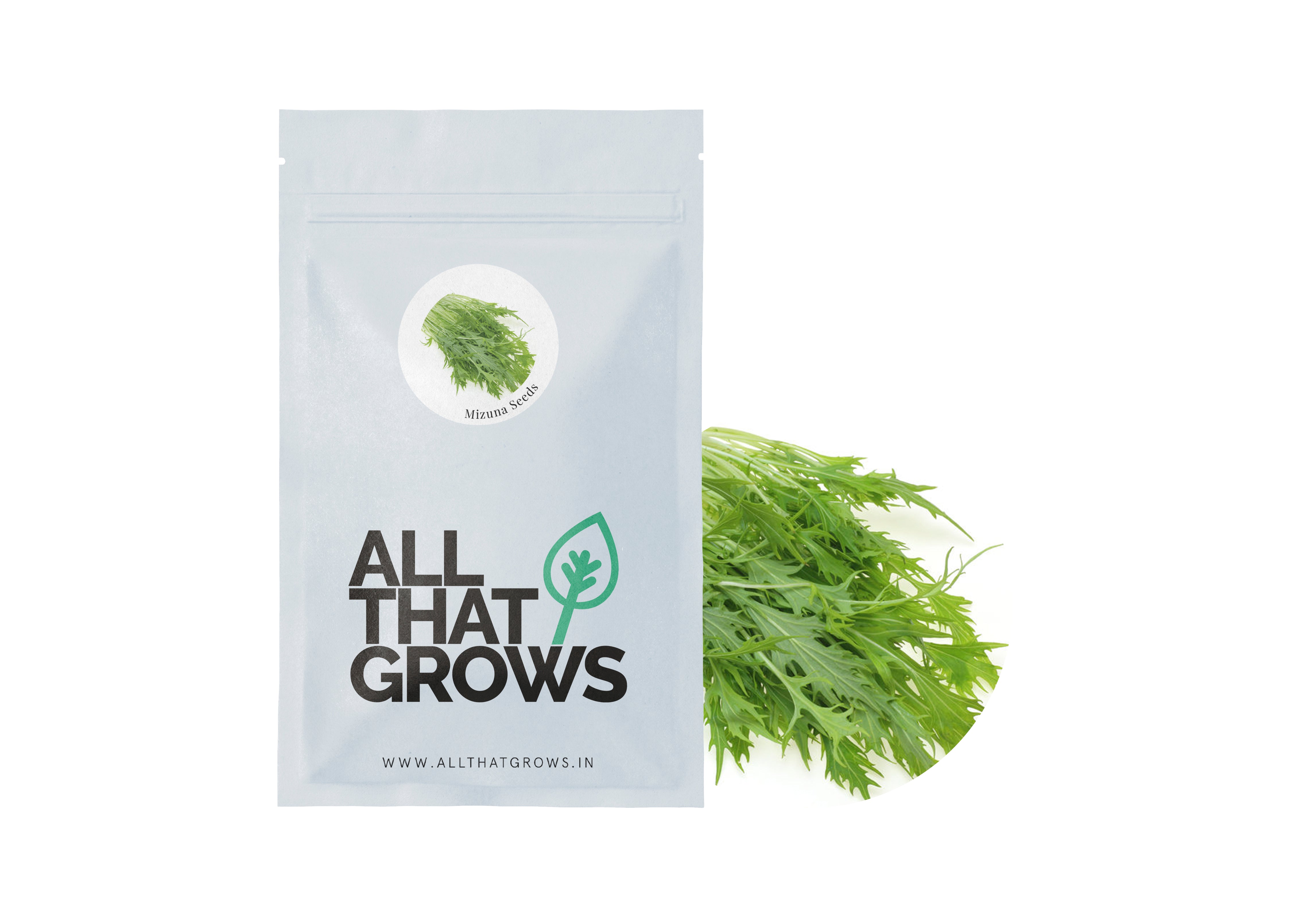



Mizuna Green Seeds
Recommended with this
Seed Type : Non-Hybrid, Open Pollinated and Non-GMO
SOWING TIME : February to May, September to November
Plant Character : Low height central stalk with leafy branches
Leaf Character : Dark green fringe-edged leaves
Harvest : 30 to 40 days after sowing
- SOWING
TIMEFebruary to May, September to November
- Sowing
DistancePlant to Plant - 4 to 6 inches, Row to Row - 12 to 16 inches
- Fruit
WeightN/A
- Fruit
ShapeN/A
- Days to
maturity30 to 40 days after sowing
- Details
- How to sow
- Reviews
A mild flavoured Japanese mustard belonging to the brassica family of plants is the fringe leaf Mizuna. A native of Kyoto, Japan, Mizuna has been cultivated since the beginning of the 19th century. Mizuna grows up to 14 to 18 inches in height with dark green fringe-edged leaves that are tender when young and become more peppery and crispy when they are fully mature. Mizuna leaves are a good source of calcium, magnesium, potassium, iron, folate and vitamins including A, C and K. Mizana can be harvested at the cotyledon or microgreen stage, baby leaf stage or as a fully mature salad green. Mizuna leaves pair well with most culinary herbs and can be used raw, steamed, boiled or in stir-frys. Authentic spring salad mix and mesclun salad mix specifically require mizuna leaves.
Planting instructions
Sow mizuna seeds in well-draining loose soil at a depth of ¼ inches in a fully sunny location. In ideal conditions, the germination should take about two weeks. Sow seeds in succession after every three weeks for a constant supply of the salad green. Mizuna, like other salad greens, can also be grown well in a container.
Growing Requirements
pests & diseases
Just like other cabbage family crops, Mizuna greens are prone to pests like flea beetle, cabbage loopers, and aphids. Use row covers to protect plants from these pests and additionally organic neem spray can help deter most of the pests.
soil
Nitrogen-rich well-draining soil with a pH ranging from 6.5 to 7 is best for growing Mizuna greens.
spot
Mizuna greens thrive in a sunny spot that receives 4-5 hours of sunlight every day.
temperature
The ideal soil temperature for germination of Mizuna greens should range between 15 to 25℃.
watering
Mizuna prefers slightly moist soil for better leaf growth. Keep the top layer of soil evenly moist with regular watering.
how to harvest
Mizuna greens can be harvested at microgreen, baby leaf or mature salad green stage of their growth. Mizuna leaves will start getting peppery and mildly bitter with age so it's best to start harvesting them in 3-4 weeks after sowing. Harvest leaves fresh when required.

Customer Reviews
The productiveness of any seed we sell is subject to your local climatic conditions*, the sowing method you adopt, and your commitment to the planting process. We give no warranty, expressed or implied, and are in no way responsible for the produce.
Please note that all our seasonal recommendations/ sowing information is as per the local climatic conditions. *For more information on the optimum conditions required for growing seeds in your region, please contact us at, hello@allthatgrows.in or Whatsapp us at, +91 8544865077
Questions & Answers
Have a Question?
Be the first to ask a question about this.




Mizuna Green Seeds
Seed Type : Non-Hybrid, Open Pollinated and Non-GMO
SOWING TIME : February to May, September to November
Plant Character : Low height central stalk with leafy branches
Leaf Character : Dark green fringe-edged leaves
Harvest : 30 to 40 days after sowing
Recommended with this
A mild flavoured Japanese mustard belonging to the brassica family of plants is the fringe leaf Mizuna. A native of Kyoto, Japan, Mizuna has been cultivated since the beginning of the 19th century. Mizuna grows up to 14 to 18 inches in height with dark green fringe-edged leaves that are tender when young and become more peppery and crispy when they are fully mature. Mizuna leaves are a good source of calcium, magnesium, potassium, iron, folate and vitamins including A, C and K. Mizana can be harvested at the cotyledon or microgreen stage, baby leaf stage or as a fully mature salad green. Mizuna leaves pair well with most culinary herbs and can be used raw, steamed, boiled or in stir-frys. Authentic spring salad mix and mesclun salad mix specifically require mizuna leaves.
Seed Type : Non-Hybrid, Open Pollinated and Non-GMO
SOWING TIME : February to May, September to November
Plant Character : Low height central stalk with leafy branches
Leaf Character : Dark green fringe-edged leaves
Harvest : 30 to 40 days after sowing
- SOWING
TIMEFebruary to May, September to November
- Sowing
DistancePlant to Plant - 4 to 6 inches, Row to Row - 12 to 16 inches
- Fruit
WeightN/A
- Fruit
ShapeN/A
- Days to
maturity30 to 40 days after sowing
Planting instructions
Sow mizuna seeds in well-draining loose soil at a depth of ¼ inches in a fully sunny location. In ideal conditions, the germination should take about two weeks. Sow seeds in succession after every three weeks for a constant supply of the salad green. Mizuna, like other salad greens, can also be grown well in a container.
Growing Requirements
pests & diseases
Just like other cabbage family crops, Mizuna greens are prone to pests like flea beetle, cabbage loopers, and aphids. Use row covers to protect plants from these pests and additionally organic neem spray can help deter most of the pests.
soil
Nitrogen-rich well-draining soil with a pH ranging from 6.5 to 7 is best for growing Mizuna greens.
spot
Mizuna greens thrive in a sunny spot that receives 4-5 hours of sunlight every day.
temperature
The ideal soil temperature for germination of Mizuna greens should range between 15 to 25℃.
watering
Mizuna prefers slightly moist soil for better leaf growth. Keep the top layer of soil evenly moist with regular watering.
how to harvest
Mizuna greens can be harvested at microgreen, baby leaf or mature salad green stage of their growth. Mizuna leaves will start getting peppery and mildly bitter with age so it's best to start harvesting them in 3-4 weeks after sowing. Harvest leaves fresh when required.



 Sign In
Sign In








